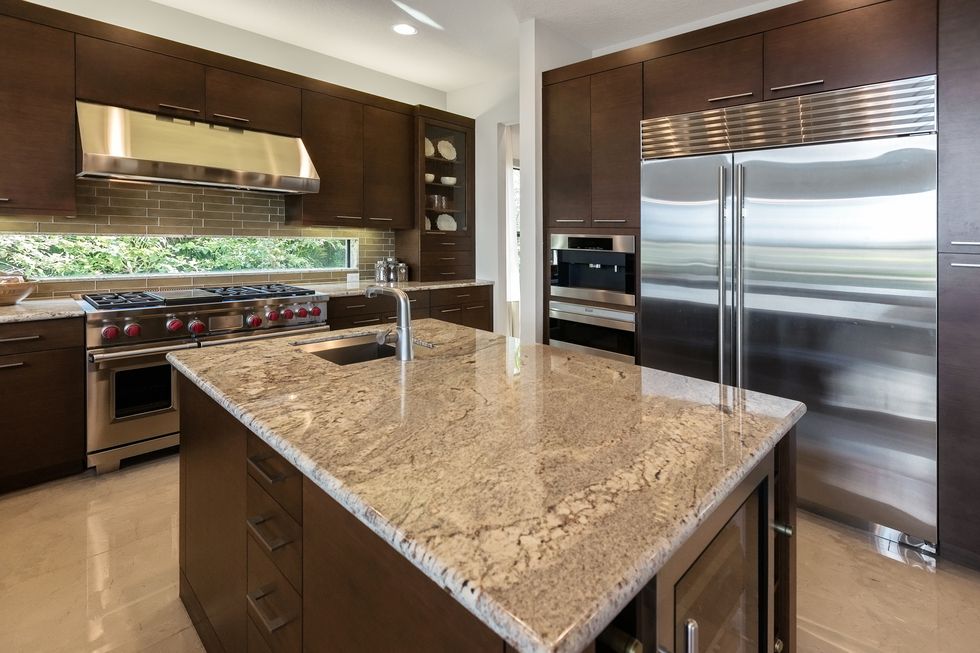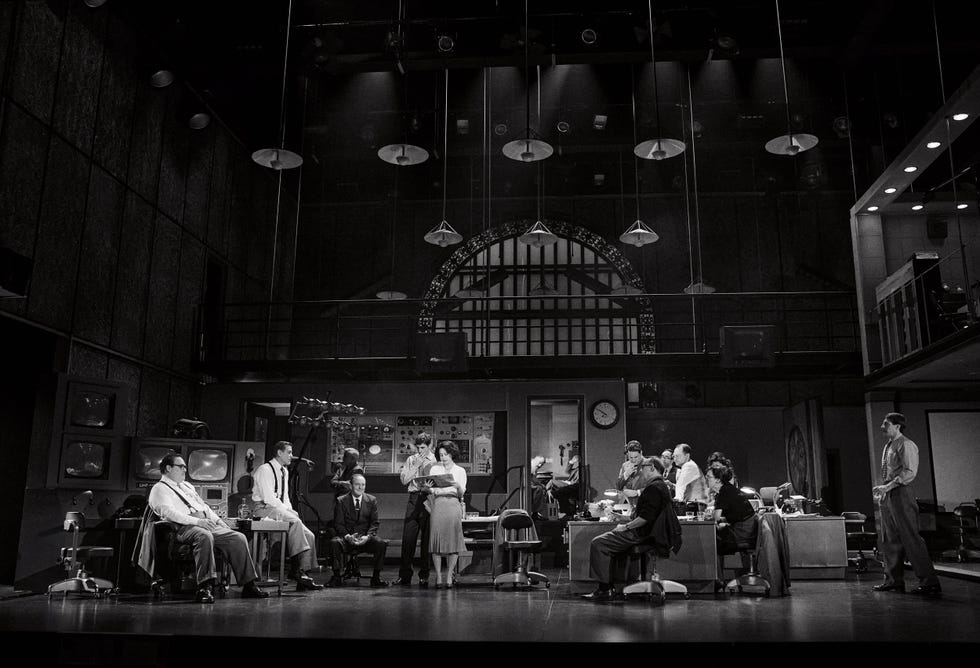Choosing a kitchen countertop is a bit like dating—you want something attractive, reliable, low-maintenance, and preferably not prone to cracking under pressure. Maybe you’re into the cool confidence of quartz, the moody mystery of soapstone, or the timeless charm of marble (just don’t mind a few beauty marks along the way).
Finding the best countertop material for your kitchen will depend on a variety of factors. Each one has different merits and drawbacks, depending on your functionality and style preferences. Before selecting an option, it’s important to consider the characteristics of each. Look into the material’s durability, cost, installation process, appearance, longevity, resistance, and maintenance requirements to make an informed choice.
Beyond that, aesthetics certainly come into play: there’s butcher block for the rustic romantics, stainless steel for the minimalists, and concrete for those who like their kitchens with a little edge. Whatever your type, there’s a countertop out there ready to commit—and yes, it’s totally okay to judge a counter by its surface.
Below is a complete guide to the most common types of countertops to help you learn more about the benefits and drawbacks of each and be ready to discover the best types of countertop materials for your kitchen.
Granite
Granite has long been a favored material for kitchen and bathroom countertops, and for good reason. As a natural stone, each slab of granite is entirely unique, featuring distinctive patterns, speckles, and color variations that can elevate the design of any space. Its organic beauty brings a sense of timelessness and elegance, complementing a wide range of interior styles, from traditional to contemporary.
Beyond its aesthetic appeal, granite is prized for its durability. It’s heat-resistant, making it ideal for busy kitchens where hot pans might be placed directly on the surface. When properly sealed, granite is also resistant to stains, scratches, and moisture—qualities that make it as practical as it is beautiful. Regular maintenance is simple and typically involves resealing once a year to preserve its protective layer. Available in a broad palette of colors—ranging from soft whites and warm beiges to dramatic blacks and deep greens—granite offers versatility for homeowners looking to personalize their space.
Quartz
Quartz has become one of the most popular choices for countertops in modern homes, thanks to its sleek appearance, wide range of colors, and low-maintenance nature. Unlike natural stone, quartz countertops are engineered from a blend of natural quartz crystals and resin, creating a non-porous, highly durable surface. This manufacturing process allows for consistent patterns and tones, giving homeowners greater control over the look and feel of their space.
One of quartz’s standout qualities is its resistance to stains, scratches, and bacteria. Because it’s non-porous, it doesn’t require sealing like granite or marble, making it an ideal choice for busy kitchens and bathrooms. Spills from wine, coffee or oils can be easily wiped away without risk of permanent damage, and daily cleaning usually requires nothing more than mild soap and water.
Design-wise, quartz offers exceptional versatility. It’s available in styles that mimic the appearance of natural stone—such as marble and granite—while also coming in solid colors and modern patterns. Whether you’re aiming for a minimalist white kitchen or a dramatic, veined surface, quartz can be tailored to suit a wide variety of aesthetics. Its durability and design flexibility make it a smart and stylish investment for any home.
Stainless Steel
Stainless steel countertops bring a clean, contemporary edge to residential kitchens, blending industrial chic with practical function. Long favored in professional kitchens for their durability and hygiene, stainless steel surfaces have made their way into modern homes as a bold design choice. Their reflective quality can visually expand a space, making them especially appealing in smaller or minimalist interiors.
Functionally, stainless steel is highly heat-resistant and impervious to water damage, stains, and rust. It’s also non-porous, which means it won’t harbor bacteria—an especially appealing feature for food preparation areas. Though it can scratch and develop a patina over time, many homeowners appreciate the evolving character it lends, embracing the soft wear as part of its charm.
Design-wise, stainless steel pairs beautifully with a wide range of materials, including wood, concrete, and stone. It can act as a striking contrast in a warm, rustic kitchen or blend seamlessly into a cool, modern space. While it may not be the traditional choice, stainless steel offers a mix of utility and sleek sophistication that makes it a standout option for contemporary countertops.
Soapstone
Soapstone is a distinctive and timeless countertop material that brings a soft, natural elegance to the home. Known for its smooth, matte texture and subtle veining, soapstone typically comes in shades of gray with hints of blue or green, and it deepens in color over time. Its understated beauty makes it a favorite in both rustic and modern interiors, where it can serve as a sophisticated focal point.
One of soapstone’s most appealing qualities is its durability. It’s naturally non-porous, so it resists stains and doesn’t require sealing. It’s also highly heat-resistant, which makes it ideal for kitchens where hot pots and pans are frequently in use. Over time, soapstone like stainless steel will develop a natural patina that many homeowners find adds character and depth to the surface.
Unlike harder stones, soapstone is relatively soft, which means it can scratch more easily than granite or quartz. However, minor scratches can often be buffed out or treated with mineral oil, which also enhances the stone’s rich, dark appearance. For those who appreciate a lived-in, evolving look and a low-maintenance surface, soapstone offers a unique blend of charm and practicality.
Marble
Marble countertops are synonymous with luxury and classic beauty, offering a timeless elegance that few materials can match. With its soft, luminous surface and graceful veining, marble brings a sense of refinement to any kitchen or bathroom. Each slab is a one-of-a-kind creation of nature, making it especially appealing for homeowners seeking a unique, artisanal look.
While marble is undeniably beautiful, it does require a bit more care than harder surfaces. It’s a porous stone, which means it can be susceptible to stains from acidic substances like wine, citrus, or vinegar if not properly sealed. It’s also softer than granite or quartz, so it can scratch and etch more easily. However, for many, these signs of wear add to marble’s charm, telling the story of a well-loved and well-used space.
Design-wise, marble is incredibly versatile. It works equally well in traditional settings with ornate detailing as it does in sleek, modern interiors. Popular varieties like Carrara, Calacatta, and Statuario offer different veining patterns and tones, from subtle grays to bold contrasts. For those who value beauty and craftsmanship, and don’t mind a little patina over time, marble is an enduring and elegant choice.
Concrete
Concrete countertops offer a bold, modern look with an artisanal edge, making them a standout choice for homeowners looking to customize their space. Unlike mass-produced materials, concrete is typically poured and finished by hand, allowing for complete control over color, shape, texture, and edge details. This makes it especially appealing in contemporary, industrial, or eclectic interiors where personalization is key.
Functionally, concrete is strong and heat-resistant, but it does require proper sealing to prevent staining and water absorption, as it is naturally porous. With the right protective finish, concrete can hold up well in both kitchens and bathrooms, though it may develop hairline cracks over time due to natural settling. Many homeowners embrace these imperfections as part of the material’s raw, organic appeal.
Visually, concrete offers a striking alternative to more traditional countertop materials. It can be tinted in various shades—from cool grays to warm earth tones—and even embedded with decorative elements like glass, stone, or metal. The result is a surface that’s as durable as it is expressive. For those drawn to a tactile, handcrafted aesthetic, concrete delivers both character and longevity.
Wood
Wood countertops bring a sense of warmth and natural beauty to the home, offering a welcoming contrast to sleek stone or metal surfaces. Often crafted from hardwoods like maple, walnut, oak, or cherry, these surfaces add rich texture and organic charm to kitchens and bathrooms alike. Whether used as a full countertop or as a butcher block accent, wood creates a cozy, lived-in feel that enhances both traditional and contemporary spaces.
One of wood’s greatest strengths is its versatility. It pairs beautifully with a range of materials—from stainless steel appliances to marble backsplashes—and can be finished in a variety of stains, oils, or sealants to suit different styles. Wood also has a gentle, forgiving surface that’s easy on dishware and comfortable for daily use. With proper maintenance, including regular sealing or oiling, wood countertops can last for decades.
However, wood is more susceptible to scratches, dents, and moisture damage than stone or engineered surfaces, so care is important—especially in areas near sinks or heavy prep zones. That said, many minor marks can be sanded out, and the material’s ability to age gracefully is part of its appeal. For those seeking a countertop that adds warmth, character, and a handcrafted feel, wood is a beautiful and timeless choice.
Solid-Surface Material
Solid-surface material is made up of a blend of acrylic or polyester resins and natural minerals, these surfaces are non-porous, low-maintenance, and available in a wide range of colors and patterns—including styles that mimic stone, concrete, or marble. Their smooth, uniform appearance lends itself well to minimalist and contemporary designs.
One of the standout features of solid-surface material is its versatility. It can be molded into custom shapes, allowing for integrated sinks, backsplashes, and even curved edges with no visible seams. The non-porous nature of the material means it resists stains, moisture, and bacteria, making it an especially hygienic option for kitchens and bathrooms. Everyday cleaning is simple—just soap and water or a mild cleanser.
While solid-surface countertops aren’t as heat- or scratch-resistant as granite or quartz, minor damage can often be buffed or sanded out, which makes maintenance relatively easy. They’re a great option for homeowners who want the look of high-end materials without the cost or upkeep. With its combination of style, functionality, and design flexibility, solid surface offers a practical yet polished countertop solution.
Ceramic Tile
Ceramic tile countertops offer a charming, budget-friendly option with plenty of room for creativity. Available in an endless variety of colors, shapes, and patterns, ceramic tiles can be arranged to create anything from a classic white grid to a vibrant mosaic. This flexibility makes tile an appealing choice for homeowners who want a custom look without a high price tag. It’s especially popular in vintage, farmhouse, or Mediterranean-style kitchens where decorative details are embraced.
Functionally, ceramic tile is heat-resistant and durable, holding up well to hot pots and pans, as well as everyday wear. However, grout lines can be a downside—while the tiles themselves are easy to clean, grout can stain or become discolored over time if not sealed and maintained properly. Choosing darker grout or sealing regularly can help minimize this issue.
One of tile’s greatest advantages is its DIY-friendliness. Homeowners with some experience can often install or repair tile themselves, which adds to its affordability. While it may not offer the seamless finish of stone or solid-surface materials, ceramic tile brings character, texture, and a touch of handmade charm to the kitchen or bathroom.
Laminates
Laminate countertops are a practical and stylish choice for homeowners seeking affordability without sacrificing design. Made from layers of paper or fabric bonded with resin and topped with a printed decorative layer, laminate offers a wide range of colors, patterns, and finishes—including convincing imitations of wood, stone, and metal. Its versatility makes it easy to match any interior style, from retro to modern minimalist.
One of laminate’s strongest selling points is its low cost and easy installation. It’s lightweight, can be cut to fit a variety of layouts, and is often a go-to option for budget-conscious remodels or quick upgrades. Cleaning is also simple—just a wipe with mild soap and water keeps the surface looking fresh. While it’s not heat-resistant like stone or metal and can be scratched or chipped, using trivets and cutting boards helps preserve its finish.
Laminate has come a long way in terms of design and durability, with modern versions offering more realistic textures and improved edge treatments. Though it may not have the longevity of materials like granite or quartz, it’s a smart, low-maintenance solution that balances style and function—perfect for high-traffic areas or secondary spaces like laundry rooms and guest bathrooms.
Rachel Silva is the associate digital editor at ELLE DECOR, where she covers all things design, architecture, and lifestyle. She also oversees the publication’s feature article coverage, and is, at any moment, knee-deep in an investigation on everything from the best spa gifts to the best faux florals on the internet right now. She has more than 16 years of experience in editorial, working as a photo assignment editor at Time and acting as the president of Women in Media in NYC. She went to Columbia Journalism School, and her work has been nominated for awards from ASME, the Society of Publication Designers, and World Press Photo.













